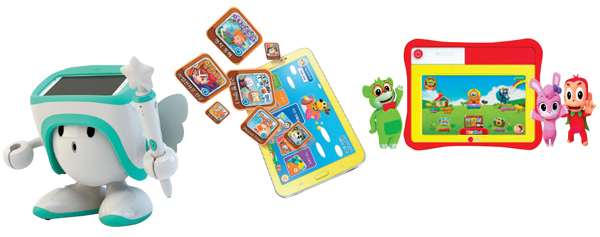Tablets for children slowly catching on

From left: SK Telecom’s Atti robot, Samsung’s Galaxy Tab 3 Kids, LG’s Kids Pad. Provided by each company
In the U.S., tablet PCs have emerged as a must-buy item for many parents. Dozens of companies are competing to sell what will be the “first tablet of life” for children.
Samsung Electronics’ Galaxy Tab 3 Kids Edition is a leader in the high-end product range. Other tablets on the market include Kurio, Nabi, Lexibook, Polaroid, MEEP!X2, FunTab, Ematic FunTab, Supersonic Munchkinz Tablet and Vinci Tab, to name a few. Tablet PCs for kids cost from $99 to $199.99 at retail stores.
Retail sellers and animation companies are also jumping on the bandwagon. For example, Toys “R” Us is selling its own tablet for kids, the Tabeo eSeries, while DreamWorks Animation is planning to release an Android tablet for children called DreamTab. Kindle Fire HD from Amazon and Apple’s iPad Mini are also popular with kids.
How is the availability of children’s tablets in Korea? The local tablet market is growing slowly compared with the domestic smartphone market. There is a limited offering of tablets for kids, but some companies are trying to break into the market, which they see as having potential for growth given Korea’s focus on early education.
The Galaxy Tab 3 Kids is one of the few available products in Korea. The 7-inch tablet features a kid-friendly interface and is pre-loaded with apps for children. Samsung’s Kids’ Store on the touch screen is a nexus for many other learning and playing apps.
The tablet also has a three-million pixel camera and runs on the Jelly Bean operating system. It costs 389,000 won ($374) in Korea but sells for $199 in the U.S.
LG Electronics released its children’s tablet, Kids Pad, in 2012. The device, rarely sold outside Korea, is equipped with children’s books and learning content tailored for kids aged 3 to 7, in subjects such as Korean language, English, mathematics and science. More kid-friendly apps are available, too.
The company was set to introduce a follow-up model this year but “the release is being delayed for the time being,” an official of the company said.
Education service providers are competing with LG and Samsung. Dream Pad by TunTun English holds 244 English-education-related programs, including English Chant, English animation and English songs. The 7.85-inch pad costs 299,000 won. TunTun English manufactures the device with its partner, Thinkware, which makes GPS navigation for cars.
CJ Educations also released an English-education tablet. The tablet, named I Think English: Sound Phonics, has a package of 20 apps.
Some companies are cutting corners by adding content to existing kids tablets and marketing it as their own. Etnus is selling the Galaxy Tab 3 Kids Magic Cheonjamun, which has content for learning 1,000 basic Chinese characters. “It is only Chinese words now, but we are planning to develop other educational content such as English,” said an official of Etnus.
Because of the habits of children - they drop things - many of tablets are sold with durable protective cases. Samsung’s Galaxy Tab 3 Kids Edition has a bright orange bumper case to reduce impact if it is dropped.
Children also tend to lose interest easily, and most kids tablets can be used as normal by switching to “parental mode.” Parental control is also an important element to a child’s device, and the available products allow a parent to set a limit on usage time, viewing and app purchases.
Korean mobile carriers have also produced their own tablets - but they look more like robots.
SK Telecom’s Atti is a robot-shaped PC developed for children aged 4 to 7. Through the touch screen on the face of the robot, children learn English or Chinese on pre-loaded apps.
KT sells a similar robot-like smart device for children, called Kibot, and its follow-up, Kibot 2.
Analysts predict the market for kids’ tablets will grow as the creation of education apps triggers demand for devices.
Sophia Kim, at Woori Investment and Securities, said the B2B market will grow quickly but that growth in the B2C market will lag behind.
“There is still a debate over whether it is good or not to teach children through those devices,” Kim said.
Some of the tablets introduced above will be showcased at the Korea Baby Fair to be held at Kintex, Ilsan, this week.
BY MOON GWANG-LIP [joe@joongang.co.kr]










with the Korea JoongAng Daily
To write comments, please log in to one of the accounts.
Standards Board Policy (0/250자)